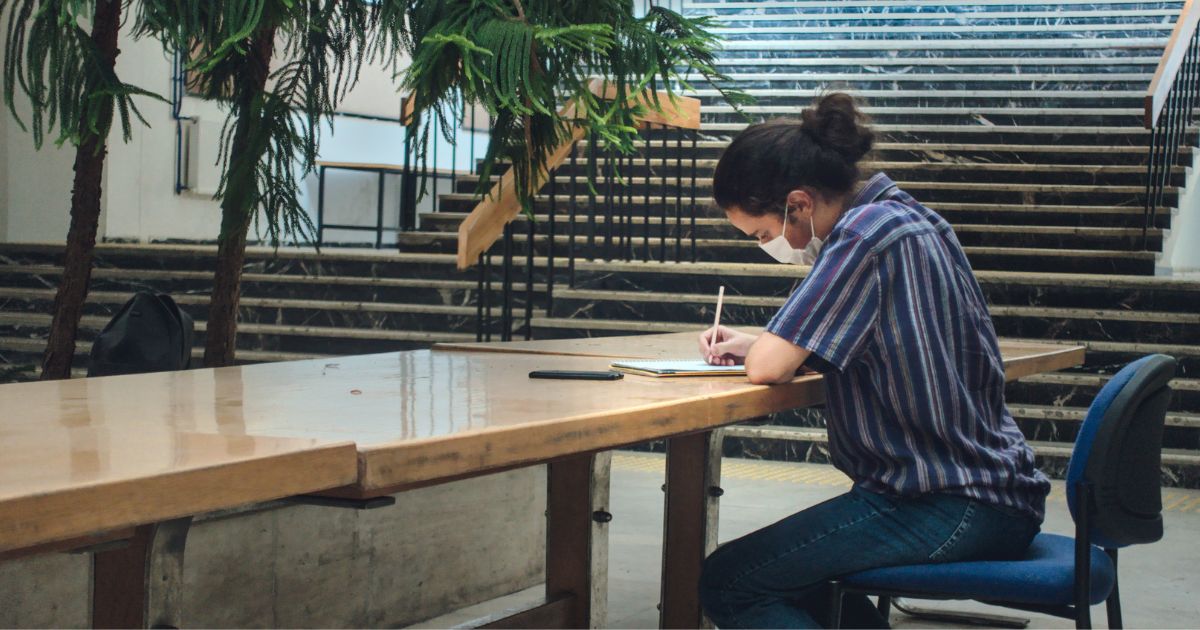Good Posture When You Draw [How to Get the Best Position]

Just like playing sports or reading a book, when you’re drawing it’s essential to pay attention to the body position for drawing, especially the hands and fingers.
Most people don’t realize it, but good posture allows you to draw faster, draw more precisely, and for longer periods of time.
It is possible to draw with bad posture, and maybe you can even draw well. But if you start out with good posture it will eventually become an automatic habit that you fall into without any extra thought or effort.
As a beginner artist, I used to experience a great amount of eye, back, neck, and shoulder strain since I used to sit in fixed, sometimes uncomfortable positions over long periods of time.
I started out sitting this way purely out of habit and as a result, simply did not realize the uncomfortable positions I was forcing my body to accommodate.
I eventually got the right positions to draw and alleviate completely the body pain I was getting.
Here are some of my acquired information on comfortable positions to draw:
Be aware of your work environment and pay attention to pain
As an artist, you can be so engrossed in your work that you simply don’t realize where the pain points are until it’s painful. Pay attention to the position of your body, the location of your tools, the height of your chair, and your lighting when you start to notice strain.
Adapt your equipment to your ideal posture, rather than compromise your posture to adapt to your equipment. Sometimes just being aware of the sources of strain will help you make modifications and eliminate them when they arise.
Sit up straight
Use an adjustable, ergonomic chair with adjustable lumbar support and armrests to support your back and the weight of your arms. You would be amazed at how much a chair with armrests helps reduce the stress on your shoulders.
In addition, a minor adjustment to the height of your chair can make a world of a difference in your comfort. Again, adjust your equipment to your most comfortable posture.
Wear your complete prescription when working (distance plus reading correction)
Why? Because it helps you sit at a comfortable, ergonomic working distance.
Many nearsighted people take off their glasses to read or work. As a result, they have to lean over to see. Can they see clearly? Probably, but they don’t make the connection between taking off their glasses to read and the resulting back and neck pain they get from having to hunch over to see.
Sometimes artists take off their glasses when they do detail work because they can’t get comfortable with the near zone in their progressive or no-line bifocals. In some glasses, the near lens portion is quite small. Consider using a standard bifocal for your creative work, as they provide a large near viewing area.
n addition, added eyestrain can occur if you work without your vision corrected. Trying to work around your actual prescription typically leads to eyestrain, headaches, and hunching.
Use proper lighting
If you use the same light bulbs you used 20 years ago, it’s time to try some brighter bulbs. As we age, our requirement for light increases.
That task lamp that worked for you years ago is likely not bright enough for your work today. It may be forcing you to lean in to see, in turn creating shadows and adding to back and eye strain.
Stop strangling your stylus.
Look at the way you’re holding your drawing implement. Are your knuckles turning red? Are your fingers blanching? Are any of your joints hyperextending (bending backward)? Do you have huge calluses on your finger? If the answer is yes to any of these questions you are probably gripping your stylus too tightly.
Keep your hand relaxed as you draw. Some of the muscles that grip your pen attach to the bones of your fingers and run up the forearm to the elbow. Tension in the fingers can contribute to repetitive stress injuries in the hand, wrist, forearm, and elbow. A relaxed grip will reduce stress on your joints and tendons and help to reduce tension in your arm, shoulder, and neck.
Warm-up!
Prepare your body to draw with a physical warm-up. Perform easy stress-free movements to lubricate joints, and prepare muscles and tendons for drawing. A full-body warm-up is ideal. Take 5 minutes to do something that will literally warm you: go on a walk; march in place, or dance to your favorite music.
Hate all those ideas? Come up with something else! Follow up whole-body movements with easy movements targeting your hands, arms, neck, and shoulders. 5 to 15 minutes of prep time, and you will feel better as you draw!
Sit up straight
Good posture helps to reduce stress on the neck, shoulders, and back. Sit forward in your chair. Put both feet on the floor. Your knees and your hips should be bent to 90°. Try not to use the backrest of your chair while you draw.
An angled drawing surface, good lighting, and/or positioning your screen at eye level could help you keep from hunching over your work. Look at your workspace. What can you do with it to help you improve your posture?
Breathe!
Slow, deep breaths can be very relaxing and help us reduce feelings of stress. For you trivia buffs, a research article investigating physical and emotional responses to deep slow breathing said, “Feelings of tension, depression, and anger were significantly reduced after attentive and relaxed breathing exercises…” and “a significant increase of pain thresholds in our subjects… after [deep slow breathing with relaxation]… indicat[es] an attenuation of pain perception (becoming less sensitive).”
When pain thresholds go up, pain perception goes down. Deep slow breathing practiced regularly can help you emotionally and physically!
Take breaks
Taking a break is the easiest thing (and the hardest thing) you can do to help prevent injury. The interval between breaks can be every 30 minutes to once an hour. Your break can last anywhere from 5-15 minutes.
You will have to experiment to determine how often your breaks should be. When you take a break stand up! Move away from the computer or desk! Do not text or do any activity that involves close work with the hands or eyes! Get a drink of water.
Do some gentle stretching. Put on some music. Get away from your desk. You will enjoy drawing more when you get back to it.
In my opinion, taking regular breaks is the most important activity of the 5 Things listed above! You are not just resting your body you are resting your brain. I know it isn’t easy to interrupt your flow because your hour is up, but do it! It’s much easier to just keep your butt in your chair.
It takes a lot of commitment and discipline to rest. I promise you, it will pay off!


![Good Posture for Bassists [Best Posture for Playing Bass]](https://www.goodposturehq.com/wp-content/uploads/thumbs_dir/Good-Posture-for-Bassists-prlo9r28a7kjuccnls4l0ln7wus4y8khcjvamosmhg.jpeg)
![Driving Posture Support [How to Achieve a Good Driving Position]](https://www.goodposturehq.com/wp-content/uploads/thumbs_dir/Driving-Posture-Support-prlmshjh06nlxtpymr9nq1iw2tbcrp420x0rm7rr2s.jpeg)
![Safest Driving Position [And Comfy for Long Trips]](https://www.goodposturehq.com/wp-content/uploads/thumbs_dir/Safest-Driving-Position-prlllxejk8e89fjh5czrts5jsr32925ku9nbd6vgt0.jpeg)
![SUV vs Sedan Good Driving Posture [Best Sitting Position]](https://www.goodposturehq.com/wp-content/uploads/thumbs_dir/Sedan-Good-Driving-Posture-prgr0xfu7wpe98up4mvnrs2g311miv57eesvnlpdck.jpeg)